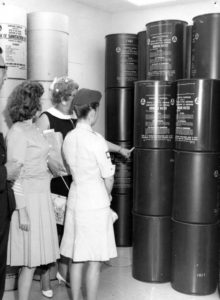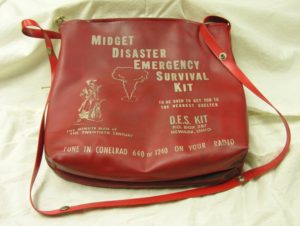Li’l Abner Saves a City

For many people, the term civil defense evokes memories of backyard bomb shelters and schoolchildren crouched under their desks during the “duck and cover” drills of the 1950s and 1960s. Although we may find these activities amusing today, the concept of civil defense in the United States dates back to the early 1900s and has taken multiple forms through the years.

The first organized, nationwide civil defense efforts started during World War I. Unlike Europe, the U.S. didn’t have to worry about air raids, so the Council of National Defense focused on recruiting, Liberty Bond drives, and general vigilance. The CND was disbanded after the “war to end all wars” ended.
In the early 1940s, with a new war looming, President Roosevelt revived and expanded U.S. civil defense programs. Even before the country entered World War II, the Council of National Defense was reactivated and then replaced by the Office of Civilian Defense, which was charged with promoting morale as well as instituting protective measures. The Civil Air Patrol (created just days before Pearl Harbor) used civilian pilots to patrol coastlines and help with search and rescue efforts. The Civil Defense Corps trained millions of volunteers to fight fires, provide first aid, and perform other post-disaster tasks. The CDC also supported anti-saboteur vigilance, recycling, and rationing—activities people of all ages could participate in.
As America transitioned from World War II to the Cold War, the country maintained civil defense efforts, and in 1951 President Truman established the Federal Civil Defense Administration. Fallout shelters, evacuation exercises, “duck and cover” drills, and educational publications and films were all part of civilian-oriented activities. Hollywood celebrities from Glenn Ford to Orson Welles to Ozzie and Harriet helped promote the message of preparedness against natural disasters and military attacks.

The State Library’s collection includes one of these educational publications—a civil defense comic book by cartoonist Al Capp. Born in 1909, Capp was the creator of the comic strip Li’l Abner, which ran for 43 years (1934-1977) and at its peak was read by an estimated 60-70 million people (roughly one third of the U.S. population at the time!). In addition to producing six dailies and one Sunday strip each week, Capp and his assistants also produced advertising, merchandising, and other specialty work as well as public service comics—including “Mr. Civil Defense Tells about Natural Disasters!” This comic was published in the late 1950s; Li’l Abner himself makes a cameo appearance on the cover and first page before leaving Mr. Civil Defense to describe the benefits of having local civil defense measures in place.
In the early 1960s, civilian civil defense activities became less frequent as awareness about the full effects of nuclear attack grew and a nuclear test ban treaty slowly began to ease relations with the Soviet Union. However, for many Ohioans, civil defense drills were as much a part of childhood as school, black-and-white television—and comic books.
Thank you to Stephanie Michaels, Research and Catalog Services Librarian at theState Library of Ohio, for this week’s post!



Leave a Reply
You must be logged in to post a comment.